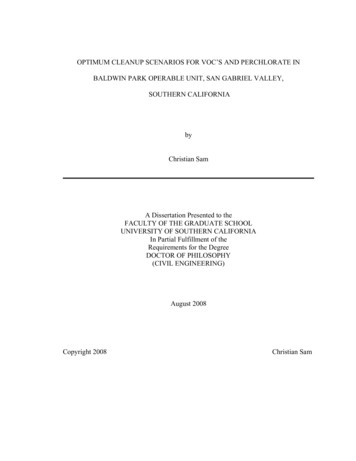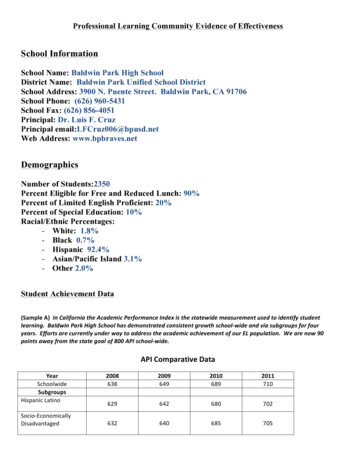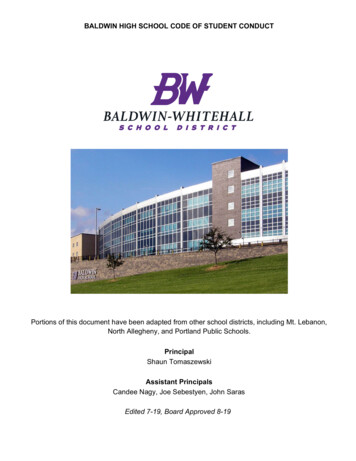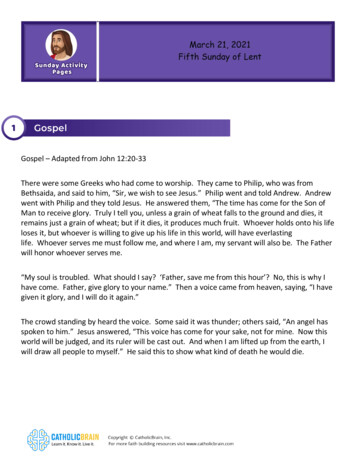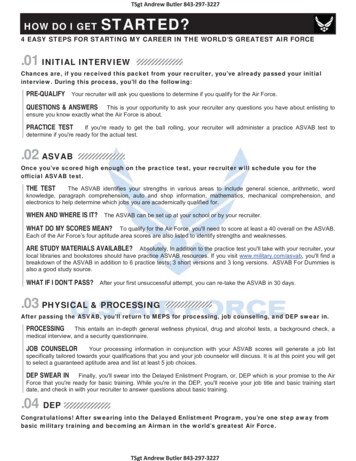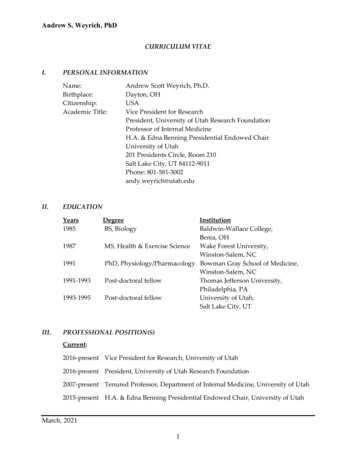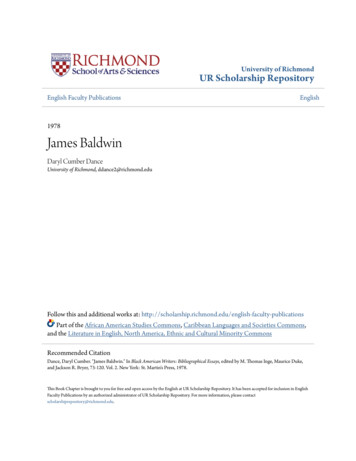
Transcription
G. Andrew Mickley, Jr.23 December 2021Present Positions:Emeritus Professor and Founding Chair, Neuroscience ProgramEmeritus Professor, Department of PsychologyBaldwin Wallace University275 Eastland RoadBerea, OH 44017-2088Visiting Professor Department of PsychologyWofford College429 N Church StSpartanburg, SC 29303Telephone:330-603-3839Mailing address:936 Ansley Ct.,Spartanburg, SC 29301Email:amickley@bw.eduEducation:B.A. in Psychology (Sociology minor)Graduated With Honors in Psychology, June 1970Gettysburg CollegeM.A. in Experimental Psychology(Physiological Psychology), June 1972University of Virginia; Mentor: Phillip J. BestThesis: Learning Phenomena and their Relationship to Neural Activityin the Hippocampus and BrainstemPh.D. in Experimental Psychology(Physiological Psychology), August 1978University of Virginia; Mentor: Phillip J. BestDissertation: Behavioral and Physiological Changes Produced byIonizing Radiation: Evidence for Hormone-Influenced Sex DifferencesIn the Rat.Post-GraduateTraining:1978-1979 Post-doctoral training in Physiological Psychology in thelaboratory of Dr. Herman Teitelbaum, Armed Forces RadiobiologyResearch Institute, Bethesda, MD1
SabbaticalExperiences:2000 Functional Magnetic Resonance Imaging (fMRI) of human brain.Massachusetts Institute of Technology (with Dr. Sue Corkin) andUniversity of Pittsburgh (with Dr. Julie Fiez). Massachusetts GeneralHospital, Visiting Fellowship Program in fMRI (1-4 March 2000)Research Interests: Neuropharmacological modulation of brain development. Memory andlearning in fetuses and neonates. Behavioral correlates of neural plasticity. Neural correlates ofacquisition, extinction and spontaneous recovery of conditioned taste tus Professor and Founding Chair, Neuroscience ProgramEmeritus Professor, Department of PsychologyBaldwin Wallace University275 Eastland RoadBerea, OH 44017-20882015-PresentVisiting Professor, Department of PsychologyWofford College429 North Church Street,Spartanburg, SC 29303-36632006-2016Executive Director, Nu Rho Psi (νρψ)Led and managed the only National Honor Society to encourage and recognize excellence inscholarly work and research in Neuroscience. Nu Rho Psi was established by the Faculty forUndergraduate Neuroscience in 2006 and incorporated as an independent 501(c)3 non-profitorganization in the state of Ohio in 2011.2006-2012Professor, Department of Psychology and the Neuroscience ProgramChairman, Neuroscience ProgramBaldwin Wallace UniversityBerea, OH 44017-2088Taught courses in Psychology and Neuroscience. Conducted research concerning the neuralsubstrate of fetal/neonatal behaviors and the role of glutamate and NMDA receptors in earlymemory formation. With NSF and NIMH support, conducted research concerning the neuralsubstrate of learning, extinction and spontaneous recovery of defensive reactions to fear.Mentored students of Neuroscience and Psychology. Chaired Neuroscience Studies Committee.2
2002-2010Director, Faculty-Student Collaboration (FSC)Baldwin-Wallace CollegeDirected the undergraduate research program including the Summer Scholars Program, FSCCourses, Student Scholar travel grants. Expanded the program to include the arts and humanities.Established and served as Managing Editor of the B-W Journal of Research and CreativeStudies.2002-2006Associate Academic DeanProfessor, Department of PsychologyDirector, Neuroscience ProgramBaldwin-Wallace CollegeBerea, OH 44017-2088Oversaw administration of Baldwin-Wallace College faculty development, new facultyorientation, faculty awards program, fall conference, aspects of faculty governance, studentconcerns, curriculum development, assessment of the academic program, Board of AcademicAppeals and faculty grants/contracts. Taught courses in Principles of Neuroscience andPhysiological Psychology. Conducted research concerning the neural substrate of fetal/neonatalbehaviors, the role of glutamate and NMDA receptors in early memory formation and the neuralsubstrate of extinction learning. Mentored students of Neuroscience and Psychology. Chaired theNeuroscience Studies Committee and newly formed Faculty-Student Collaborative ScholarshipProgram.1993-2002Professor and Chair, Department of PsychologyDirector of the Neuroscience ProgramCarnegie HallBaldwin-Wallace CollegeBerea, OH 44017-2088Taught courses in Principles of Neuroscience, Physiological Psychology, Psychopharmacology,Principles of Psychology, Research Methods I, II, and Special Topic Seminars. Conductedresearch concerning neural transplantation, neonatal behaviors and the role of glutamate andNMDA receptors in early memory formation. Mentored students of Psychology. Provideleadership of Psychology Department. Chaired Neuroscience Studies Committee.1990-1993Adjunct Professor, Division of Radiological SciencesUniversity of Texas Health Sciences Center at San AntonioSan Antonio, TX 78284-7800Taught behavioral radiobiology in graduate Radiobiology course. Acted as Co-Investigator onresearch projects developing a high-speed network for digital radiological imaging resources3
(e.g., PET, MRI). Acted as Associate Investigator on an NIH-sponsored training grant inEnvironmental Radiation Toxicology.1989-1993Scientific Director, Behavioral Neuroscience GroupDirected Energy DivisionArmstrong Laboratory for Human SystemsBrooks Air Force Base, TX 78235-5000Performed research in the fields of Behavioral Neuroscience, Neurotoxicology andNeuropharmacology. Managed a multidisciplinary research department studying the behavioraland biological effects of non-ionizing microwave radiations. Directed and coordinated thescientific program of the Directed Energy Division. This department included over 40psychologists, physiologists, physicists, chemists, engineers and technicians and had an annualbudget of more than five million dollars. Practiced Total Quality Management. Conceived,performed and published experiments concerning the neural substrate of learning and memory,neural transplantation, radiofrequency radiation effects on memory, thermotolerance, heat shockprotein production, local cerebral glucose utilization and blood flow.1989-1993Adjunct Associate ProfessorDivision of Life SciencesUniversity of Texas at San AntonioSan Antonio, TX 78285-0662Taught Neuroscience within undergraduate course on Human Physiology and Performance.Maintained collaborations concerning functional evaluations of neural graft/hostinterconnections.1983-1989Chief, Experimental Psychology Division,Behavioral Sciences Department,The Armed Forces Radiobiology Research Institute,Bethesda, MD 20814-5145Directed the research of 15 scientists and technicians. Designed, performed and publishedexperiments that used opiates and excitatory amino acids to model effects of ionizing radiations.Pioneered neural grafting to reverse appetitive disorders and hippocampal damage. Techniquesused: Intracranial drug injections, microdissection, neural transplantation, rotation, passiveavoidance and locomotor movement analyses. Lectured physicians and other health careproviders on the behavioral and psychological effects of ionizing radiation exposure.4
1983-1989Adjunct Associate Professor,Department of PhysiologyUniformed Services University of the Health Sciences,Bethesda, MD 20814-5145Taught neurophysiology to first-year medical students in the Human Physiology course.1981-1983, Associate Professor, 1979-1981, Assistant Professor,Department of Behavioral Sciences and Leadership,The United States Air Force Academy,CO 80840Course Director for Honors Introductory Psychology, Learning/Experimental Psychology andPsychobiology courses. Advised undergraduate students at the Academy and graduate studentresearch at the University of Colorado. Received the largest research grant in U.S. Air ForceAcademy history. Planned, performed and published experiments concerned with opiate-inducedchanges in behavior and the use of pharmacological agents to model radiogenic behavioralchanges. Supervised one technician, other faculty teaching associates and five student laboratoryassistants per semester. Received United States Air Force Research and Development Award (aNational Honor) for scientific excellence.1981-1983Adjunct Associate ProfessorDepartment of Psychology,University of Colorado,Colorado Springs, CO 80840Advised and supervised psychology graduate students who were matriculating at the Universityof Colorado at Colorado Springs while conducting behavioral neuroscience research in mylaboratory at the United States Air Force Academy.1976-1979Principal Investigator,Physiological Psychology Division,Behavioral Sciences Department,The Armed Forces Radiobiology Research Institute,Bethesda, MD 208l4-5145Conceived, designed, performed and published experiments on the psychopharmacology ofcatalepsy, movement and the behavioral toxicology of ionizing radiation. Techniques used:Active/passive avoidance and locomotor activity measurements, peripheral and intracranial druginjections, brain stimulation, stereotaxic surgery and 2-Deoxyglucose autoradiography.Supervised two research technicians. Taught Basic Neuroanatomy/Neurophysiology to nursingstudents at Walter Reed Army Medical Center.5
1975Instructor of Psychology,San Antonio CollegeTaught courses (e.g., Abnormal Psychology, Introductory Psychology) in the undergraduatePsychology curriculum.1974-1976, Test Review Psychologist1972-1974, Test PsychologistUSAF Occupational Measurement CenterLackland AFB, TXDirected the development and review of achievement tests for USAF airmen promotions. Usedpsychometric techniques to insure reliability and validity of tests spanning over 30 career fields.Managed teams of 5-20 specialists, test psychologists and reviewers responsible for testconstruction.1971-1972 Philip Francis DuPontTeaching Fellow,Department of Psychology,University of VirginiaCharlottesville, VATaught undergraduate course in Physiological Psychology. Performed experiments thatdescribed changes in single brain neuron electrophysiology during learning.Military Service:Commissioned June 1970, United States Air ForceActive Duty: 1972 - 1993,Retired, Lieutenant Colonel,AFSCs: 2675, Behavioral Scientist; 2611, Scientific ManagerSpecial Assignment: 1986-1988, Founding Member and Officer in Charge of the MedicalRadiobiology Advisory Team. Provided rapid behavioral analysis, medical advice and treatmentfor victims of radiation accidents worldwide.Grants Awarded:1977-1979 and 1984-1989 Defense Nuclear Agency, FundedResearch and Technology Work Units in Behavioral Neuroscience.(Awarded 1,000,000)1979-1980 Grant from USAF School of AerospaceMedicine: Radiogenic Changes in Physiology and Behavior.(Awarded 90,000)6
Grants (Cont.)1981-1983 Grant from Defense Nuclear Agency: Neuroanatomicaland Neuropharmacological Substrates of Radiogenic Changesin Behavior.(Awarded 300,000)1989-1993 USAF School of Aerospace Medicine intramuralfunding of research in Behavioral Toxicology of RadiofrequencyRadiation Exposure. (Awarded 600,000)1991-1993 AFOSR Independent Laboratory Research Grant(peer-reviewed, extramural): Neural Transplantation and Memory.(Awarded 138,000)1994-1996 National Science Foundation Grant (peer-reviewed,extramural): Instrumentation to facilitate undergraduate experiences inbehavioral neuroscience. (Awarded 77,912)1995-1996 Gund Foundation GrantNeural transplantation and conditioned taste aversions. (Awarded 3,000)1996-1999 National Science Foundation Grant (peer-reviewed,extramural): Neuropharmacology of early memory formation(IBN-9514799). (Awarded 210,000)1997 National Science Foundation Grant (peer-reviewed,extramural): Undergraduate Research Supplement (To pay forstudent salaries in Summer). (Awarded 6,000)1998 National Science Foundation Grant (peer-reviewed,extramural): Undergraduate Research Supplement (To pay forstudent salaries in Summer). (Awarded 12,000)1999 National Science Foundation Grant (peer-reviewed,extramural): Undergraduate Research Supplement (To pay forstudent salaries in Summer). (Awarded 5,000)2000 National Science Foundation Grant (peer-reviewed,extramural): Undergraduate Research Supplement (To pay forstudent salaries in Summer). (Awarded 10,000)2001-2003 National Institutes of Health Grant (peer-reviewed,extramural): Brain mechanisms of learning and extinction. (Awarded 100,000)7
Grants (Cont.)2003-2006 National Institutes of Health Grant (peer-reviewed,extramural): Neural Mechanisms of Extinction and SpontaneousRecovery. (Awarded 150,000)2004-2007 McGregor Fund (peer-reviewed,extramural): Summer Scholars Program, Baldwin-Wallace College.(Awarded 100,000)2006 Gund Foundation Grant (peer-reviewed, intramural):Extinction and spontaneous recovery alters c-fos expression in the brain( 3,000)2006 Gigax Travel Grant (peer-reviewed, intramural): IBNS meetingsupport ( 1,400)2006-2009 National Institutes of Health Grant (peer-reviewed,extramural): Neural Mechanisms of Extinction and SpontaneousRecovery. (Awarded 150,000)2007 Gund Foundation Grant (peer-reviewed, intramural):Extinction and spontaneous recovery alters c-fos expression in the brain(Awarded 3,000)2008 Codrington Foundation Grant (peer-reviewed, extramural): SummerScholars Program, Baldwin-Wallace College ( 25,000)2008 Gund Foundation Grant (peer-reviewed, intramural):EU Extinction and spontaneous recovery alters c-fos expressionin the brain (Awarded 3,000)2008 Research and Publication Grant (peer-reviewed, intramural):Measurement of NMDA NR2B receptors in fetal rat brain (Awarded 2,217)2008 Scholarly Presentation Grant (peer-reviewed, intramural): IBNSmeeting travel support ( 1,818)2009 Codrington Foundation Grant (peer-reviewed, extramural): SummerScholars Program, Baldwin-Wallace College (Awarded 25,000)2009 Gund Foundation Grant (peer-reviewed, intramural):The role of the Periaqueductal Gray in the spontaneous recovery ofa conditioned taste aversion (Awarded 3,000)8
Grants (Cont.)2009-2011 National Institutes of Health Grant (peer-reviewed,extramural): Supplement to Neural Mechanisms of Extinction andSpontaneous Recovery: “Summer Research Opportunities forUndergraduates” (Awarded 42,739)2009-2011 National Institutes of Health Grant (peer-reviewed,extramural): Network of educators and undergraduates for research inneuroscience. Co-PI with Dr. Cheryl Frye, University of Albany, NY.( 2,000,000 requested – Not funded)2010 Codrington Foundation Grant (peer-reviewed, extramural): SummerScholars Program, Baldwin-Wallace College (Awarded 15,000)2010 Baldwin-Wallace College, Faculty Development grant (peerreviewed, intramural): to support the Summer Scholars Program,Baldwin-Wallace College (Awarded 8,400)2011 Baldwin-Wallace College, Faculty Development grant (peerreviewed, intramural): to support travel to 2011 IBNS meeting,Baldwin-Wallace College (Awarded 1,485)2012-2013 NeuroScience Associates Grant to support the Nu Rho PsiEndowment Fund (Awarded 20,000)Professionaland HonorarySocieties:Association for Psychological Science (APS) (Fellow),American Association for the Advancement of Science,British Brain Research Association,Council on Undergraduate Research (Counselor, 2001-2011),European Brain and Behavior Society,Faculty for Undergraduate Neuroscience (FUN) (Fellow),International Behavioral Neuroscience Society(Founding Member and Fellow),International Brain Research Organization,International Society for Neuroimmunomodulation,Midwestern Psychological Association (Charter Fellow),Radiation Research Society,Society for Neuroscience,Advisory Council, North East Ohio Chapter Society for Neuroscience,Society of Toxicology, Neurotoxicology Specialty Section,International Neurotoxicology Association,World Federation of Neuroscientists.9
Honor Societies:Nu Rho Psi (Founding member and Executive Director, 2006-2016)Psi Chi (National Psychology Honorary),Phi Sigma Society (Biological Research Honorary),Sigma Xi (National Research Honorary)Omicron Delta Kappa (Leadership, Honorary member)Journal and GrantReview Activities:Journal Referee for:Brain Research BulletinDevelopmental PsychobiologyJournal of NeuroscienceLearning & MemoryLife SciencesNeurosciencePhysiology and BehaviorPharmacology, Biochemistry and BehaviorRadiation ResearchScienceGrant Referee for:National Institutes of Health (Ad Hoc: Neurology B Study Section)National Science FoundationNational Research CouncilPublic Health ServiceVeteran's AdministrationEditorial Board Memberships:Associate Editor, Journal of Neural Transplantation and Plasticity(1995-1996)Editor, 1981-1982, Proceedings of the Psychology in the DoDSymposiumManaging Editor, 2008-2011, Journal of Research and Creative ent Peer ReviewerAllegheny College (PA) (2006)Westminster College (PA) (2012)10
Awards & Citations: Undergraduate Neuroscience Program of the Year (2012), Awarded to theNeuroscience Program originated by Dr. Mickley, Society forNeuroscienceBechberger Award for Human Development (2012)Baldwin-Wallace CollegeLifetime Achievement Award (2011), Faculty for UndergraduateNeuroscienceDistinguished Alumnus award (2010), Gettysburg CollegeStrosacker Award for Excellence in Teaching (2009)Baldwin Wallace CollegeOhio Professor of the Year (2008): The Carnegie Foundation for theAdvancement of Teaching and the Council for Advancement andSupport of EducationEducator of the Year (2007): Faculty for Undergraduate NeuroscienceOhio Top Educator Award (2003): Ohio MagazineGigax Faculty Scholarship Award – Baldwin-Wallace CollegeUnited States Air Force Research and Development Award inRadiation Biology (1981): USAFCited in: Men of Achievement, Who's Who in the East, Who's Who inAmerican Education, Who's Who in Science and Engineering, Who's Whoof Emerging Leaders in America, The International Directory ofDistinguished Leadership.Other Memberships: Member, Hanson House (Traumatic Brain Injury support organization)Advisory Board (2011-present)Chair, Nominating Committee, International BehavioralNeuroscience Society (1995-96; 2008-2010).Member, Institute of Electrical and Electronics Engineers (IEEE)Standards Coordinating Committee SCC28 on Non-Ionizing RadiationHazards; Member, IEEE/USA Committee on Man and Radiation;11
Peer-reviewed Journal Publications and Book Chapters (most recent, listed last within eachtopical section):Learning and Memory:Best, P.J., Best, M.R. and Mickley, G.A. Conditioned aversion to visual environmental stimuliresulting from gastrointestinal distress. Journal of Comparative and Physiological Psychology,1973, 85, 250-257.Mickley, G.A., Cobb, B.L., Mason, P.A. and Farrell, S. Disruption of a putative workingmemory task and selective expression of brain c-fos following microwave-induced hyperthermia,Physiology and Behavior, 1994, 55, 1029-1038.Mickley, G.A., Lovelace, J.D., Farrell, S.T. and Chang, K.S. The intensity of fetal taste aversionis modulated by the anesthesia used during conditioning. Developmental Brain Research, 1995,85, 119-127.Cobb, B.L., Ryan, K.L., Frei, M.R., Guel-Gomez, V. and Mickley, G.A. Chronic administrationof L-NAME in drinking water alters working memory in rats. Brain Research Bulletin, 1995, 38,203-207.Mickley, G.A. and Cobb, B.L. Thermal tolerance reduces hyperthermia-induced disruption ofworking memory: a role for endogenous opiates? Physiology and Behavior, 1998, 63, 855-865.Mickley, G.A., Schaldach, M.A., Snyder, K.J., Balogh, S.A., Len, T., Neimanis, K., Goulis,P.M., Hug, J., Sauchak, K., Remmers-Roeber, D.R., Carter, C. and Yamamoto, B.K. KetamineBlocks a Conditioned Taste Aversion (CTA) in Neonatal Rats. Physiology and Behavior, 1998,64, 381-390.Mickley, G.A., Remmers-Roeber, D., Crouse, C., Walker, C. and Dengler, C. Detection ofnovelty by perinatal rats. Physiology and Behavior, 2000, 70, 217-225.Mickley, G.A., Remmers-Roeber, D., Crouse, C. and Peluso, R. Ketamine blocks a tastemediated conditioned motor response in perinatal rats. Pharmacology, Biochemistry andBehavior, 2000, 66, 547-552.Mickley, G.A., Remmers-Roeber, D., Crouse, C. and Peluso, R. Ketamine blocks a tasterecognition memory in fetal rats. Pharmacology, Biochemistry and Behavior, 2000, 67, 575-581.Mickley, G.A., Remmers-Roeber, D.R., Dengler, C.M., Kenmuir, C.L. and Crouse, C.Paradoxical effects of ketamine on the memory of fetuses of different ages. Developmental BrainResearch, 2001, 127, 71-76.12
Mickley, G.A., Remmers-Roeber, D.R., Dengler, C.M., McMullen, C.A., Kenmuir, C.L.,Girdler, B., Crouse, C. and Walker, C. Simple behavioral methods to assess the effect of drugs ortoxins on sensory experience. Journal of Neuroscience Research Methods, 2002, 115, 85-92.Mickley, G.A., Kenmuir, C.L., Dengler-Crish, C.M., McMullen, C., McConnell, A.M. andValentine, E. Repeated exposures to gustatory stimuli produce habituation or positive contrasteffects in perinatal rats. Developmental Psychobiology, 2004, 44, 176-188.Mickley, G.A., Kenmuir, C.L., McMullen, C. A., Yocom, A. M., Valentine, E. L., DenglerCrish, C.M., Weber, B., Wellman, J. A. and Remmers-Roeber, D. R. Dynamic Processing ofTaste Aversion Extinction in the Brain. Brain Research, 2004, 1061/1, 79-89.Mickley, G.A., Kenmuir, C.L., McMullen, C., Snyder, A., McConnell, A.M., Likins-Fowler,Valentine, E., Weber, B. and Biada, J.M. Long-term age-dependent behavioral changesfollowing a single episode of fetal N-methyl-D-Aspartate (NMDA) receptor blockade. BMCPharmacology, 2004, 4:28. les/10.1186/1471-2210-4-28Mickley, G.A., Kenmuir, C.L., Yocom, A.M., Wellman, J.A., and Biada, J.M. A Role forprefrontal cortex in extinction of a conditioned taste aversion. Brain Research, 2005, 1051, 176182.Mickley, G.A., Hoxha, Z., Bacik, S., Kenmuir, C.L., Wellman, J.A., Biada, J.M. and DiSorbo, A.Spontaneous recovery of a conditioned taste aversion differentially alters extinction-inducedchanges in c-Fos protein expression in rat amygdala and neocortex. Brain Research, 2007, 1152,139-157.DiSorbo, A., Wilson, G.N., Bacik, S., Hoxha, Z., Biada, J.M. and Mickley, G.A. Time-dependentretrograde amnesic effects of muscimol on conditioned taste aversion extinction. Pharmacology,Biochemistry and Behavior, 2009, 92, 319-326.Mickley, G.A., Disorbo, A., Wilson, G.N., Huffman, J., Bacik, S., Hoxha, Z., Biada, J.M. andKim, Y.-H. Explicit disassociation of a conditioned stimulus and unconditioned stimulus duringextinction training reduces both time to asymptotic extinction and spontaneous recovery of aconditioned taste aversion. Learning & Motivation, 2009, 40, 209-220.Wilson, G.N., Mickley, G.A., and Matera, K.M. The efficacy of ellagic acid in attenuatingneurophysiological and cognitive-behavioral symptoms associated with infusion of amyloid-beta(Aβ) peptide fragments in adult rats. Journal of Research and Creative Studies, 2010, 3(1), 1530.13
Mickley, G.A., Wilson, G.N., Remus, J.L., Ramos, L., Ketchesin, K.D., Biesan, O.R.,Luchsinger, J. and Prodan, S. Periaqueductal gray c-fos expression varies relative to the methodof conditioned taste aversion extinction employed. Brain Research, 2011, 1423, 17-29.Wilson, G.N., Biesan, O.R., Remus, J.L. and Mickley, G.A. Baclofen alters gustatorydiscrimination capabilities and induces conditioned taste aversion. BMC Research Notes, 2011,4, 527. Available: y, G.A, Remus, J.L., Ramos, L. Wilson, G.N., Biesan, O.R. and Ketchesin, K.D. Acute,but not chronic, exposure to D-Cycloserine facilitates extinction and modulates spontaneousrecovery of a conditioned taste aversion. Physiology and Behavior, 2012, 105, 417-427.Mickley, G.A., Hoxha, N., Luchsinger, J., Rogers, M.M., and Wiles, N. Electrical stimulation ofthe periaqueductal gray enhances spontaneous recovery of a conditioned taste aversion. BrainResearch, 2013, 1493, 27-39.Mickley, G.A., Hoxha, N., Luchsinger, J., Rogers, M.M., and Wiles, N. Chronic dietarymagnesium-L-threonate speeds extinction and reduces spontaneous recovery of a conditionedtaste aversion. Pharmacology, Biochemistry and Behavior, 2013, 106, 16-26.Mickley, G.A., Hoxha, Z., DiSorbo, A., Wilson, G., Remus, J., Biesan, O., Ketchesin, K.,Ramos, L., Luchsinger, J.R., Prodan, S. Rogers, M.M., Wiles, N.R. and Hoxha, N. Latentinhibition of a conditioned taste aversion in fetal rats. Developmental Psychobiology, 2014, 56,435-447. doi: 10.1002/dev.21110Mickley, G.A. A review of: “From Augustine of Hippo’s Memory Systems to Our ModernTaxonomy in Cognitive Psychology and Neuroscience of Memory: A 16-Century Nap ofIntuition before Light of Evidence” by, Jean-Christophe Cassel, Daniel Cassel, and LilianneManning. The New Mercersburg Review, Spring 2015, 52, 47-50.Neural Transplantation:Mickley, G.A., Teitelbaum H. and Reier, P.J. Fetal hypothalamic brain grafts reduce the obesityproduced by ventromedial hypothalamic lesions. Brain Research, 1987, 424, 238-248.Mickley, G.A., Ferguson, J.L., Nemeth, T.J. and Mulvihill, M.A. Neural grafts reversebehavioral deficits associated with early radiation-induced brain damage. Brain Research, 1990,509, 280-292.Mickley, G.A., Ferguson, J.L., Mulvihill, M.A. and Nemeth, T.J. Early neural grafts transientlyreduce the behavioral effects of radiation-induced fascia dentata granule cell hypoplasia. BrainResearch, 1991, 550, 24-34.14
Hippocampus and Behavior:Mickley, G.A. and Ferguson, J.L. Enhanced acoustic startle responding in rats with radiation-induced hippocampal granule cell hypoplasia. Experimental Brain Research, 1989, 75,28-34.Mickley, G.A., Ferguson, L.J., Nemeth T.J., Mulvihill, M.A. and Alderks, C. SpontaneousPerseverative turning in rats with radiation-induced hippocampal damage. BehavioralNeuroscience, 1989, 103, 722-730.Mickley, G.A., Ferguson, J.L., Mulvihill, M.A. and Nemeth, T.J. Progressive behavioralchanges during the maturation of rats with early radiation-induced hypoplasia of fascia dentatagranule cells. Neurotoxicology and Teratology, 1989, 11, 385-393.Mickley, G.A., Ferguson, J.L. and Nemeth, T.J. Serial injections of MK-801 (Dizocilpine) inneonatal rats reduce behavioral deficits associated with X-ray induced hippocampal granule cellhypoplasia. Pharmacology, Biochemistry and Behavior, 1992, 43, 785-793.Stress, Opioids and Endorphins:Mickley, G.A., Stevens, K.E., White, G.A., and Gibbs, G.L. Endogenous opiates mediateradiogenic behavioral change, Science, 1983, 220, 1185-1187.Mickley, G.A., Stevens, K.E., Burrows, J.M., White, G.A., and Gibbs, G.L. Morphine toleranceoffers protection from radiogenic performance deficits. Radiation Research, 1983, 93, 381-387.Mickley, G.A., Stevens, K.E., White, G.A. and Gibbs, G.L. Changes in morphineself-administration after exposure to ionizing radiation: Evidence for the involvement ofendorphins. Life Sciences, 1983, 33, 711-718.Mickley, G.A., Sessions, G.R., Bogo, V. and Chantry, K.H. Evidence for endorphin-mediatedcross-tolerance between chronic stress and the behavioral effects of ionizing radiation. LifeSciences, 1983, 33, 749-754.Mickley, G.A., Stevens, K.E., Moore, G.H., Deere, W., Mueller, G., White, G.A., and Gibbs,G.L. Ionizing radiation alters beta-endorphin-like immuno-reactivity in brain but not blood.Pharmacology, Biochemistry, and Behavior, 1983, 19, 979-983.Mickley, G.A., Stevens, K.E. and Galbraith, J.A. Quaternary naltrexone reverses morphine-induced behaviors. Physiology and Behavior, 1985, 35, 249-253.Mickley, G.A. Histamine H2 receptors may mediate morphine-induced locomotor hyperactivityof the C57BL/6J mouse. Behavioral Neuroscience, 1986, 100, 79-84.15
Stevens, K.E., Mickley, G.A. and McDermott, L.J. Brain areas involved in production ofmorphine-induced locomotor hyperactivity of the C57BL/6J mouse. Pharmacology,Biochemistry and Behavior, 1986, 24, 1739-1747.Mickley, G.A., Mulvihill, M.A. and Postler, M.A. Brain mu and delta opioid receptors mediatedifferent locomotor hyperactivity responses of the C57BL/6J mouse. Psychopharmacology,1990, 101, 332-337.Psychopharmacology:Mickley, G.A. and Teitelbaum, H. Movement induced in cataleptic rats: Differential effectsproduced by electrical stimulation of the lateral hypothalamus, substantia nigra, and reticularformation. Psychopharmacology, 1978, 57, 145-149.Teitelbaum, H., Giammatteo, P. and Mickley, G.A. Differential effects of localized lesions of n.accumbens on morphine-and amphetamine-Induced locomotor hyperactivity in the C57BL/6Jmouse. Journal of Comparative and Physiological Psychology, 1979, 93, 745-751.Mickley, G.A. and Teitelbaum, H. Yohimbine blocks lateral-hypothalamic-mediated behaviors.European Journal of Pharmacology, 1979, 60, 143-151.Brain Mechanisms of Radiation-Induced Behavioral Change:Mickley, G.A. and Teitelbaum, H. Persistence of lateral hypothalamic-mediated behaviors aftera supralethal dose of ionizing radiation. Aviation, Space and Environmental Medicine, 1978, 49,868-873.Mickley, G.A. Blood Pressure and Behavior of Male and female Rats are Differentially AlteredImmediately After Exposure to Ionizing Radiation. Proceedings, Psychology in the Departmentof Defense (Sixth Symposium), USAFA-TR-76-12, 1978, 349-351.Mickley, G.A. Behavioral and physiological changes produced by a supralethal dose of ionizingradiation: Evidence for hormone-Influenced sex differences in the rat. Radiation Research,1980, 81, 48-75.Mickley, G.A. Antihistamine Radiation Protection is Dissimilar from Estrogen RadiationProtection. Proceedings, Psychology in the Department of Defense (Seventh Symposium),USAFA-TR-80-12, 1980, 325-329.Mickley, G.A. Antihistamine provides sex-specific radiation protection, Aviation, Space, andEnvironmental Medicine, 1981, 52, 247-250.16
Mickley, G.A., Teitelbaum, H., Parker, G.A., Vieras, F., Dennison, B.A. and Bonney, C.H.Radiogenic changes in the behavior and physiology of the spontaneously hypertensive rat:evidence for a dissociation between acute hypotension and incapacitation, Aviation, Space, andEnv
Program. 1993-2002 Professor and Chair, Department of Psychology Director of the Neuroscience Program Carnegie Hall Baldwin-Wallace College Berea, OH 44017-2088 Taught courses in Principles of Neuroscience, Physiological Psychology, Psychopharmacology, Principles of Psychology, Research Methods I, II, and Special Topic Seminars. Conducted
